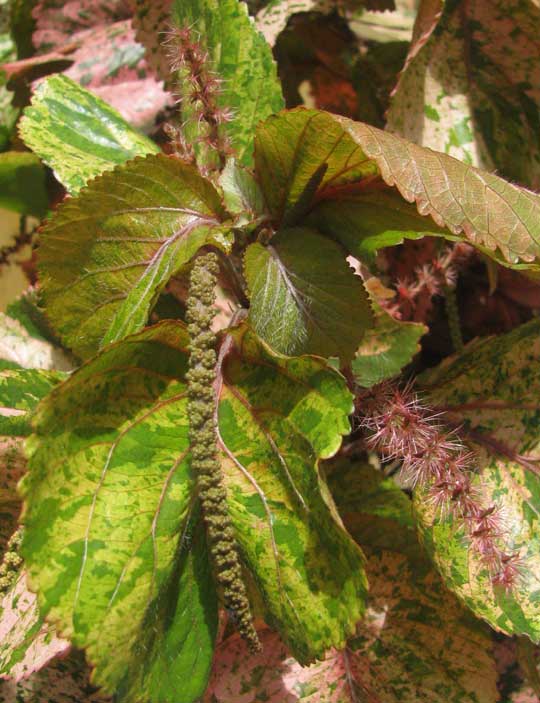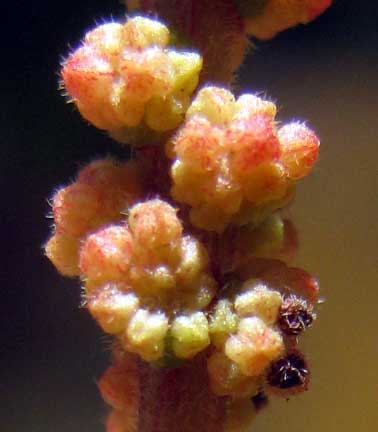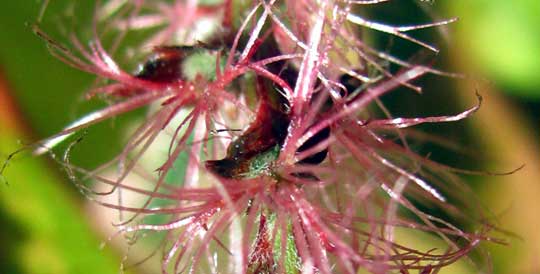Excerpts from Jim Conrad's
Naturalist Newsletter
from the July 4,, 2010 Newsletter issued from Hacienda Chichen Resort beside Chichén Itzá Ruins, central Yucatán, MÉXICO; limestone bedrock, elevation ~39m (~128ft), ~N20.676°, ~W88.569°
COPPERLEAF
Here and there around Hacienda Chichen they've planted Copperleaf, ACALYPHA WILKESIANA, whose variegated, rainbow-colored leaves and flower spikes are shown below:

Copperleaf is native to Fiji and nearby islands in the South Pacific. It's a shrub growing up to 15 feet tall (4.5 m), though here most plants are only about head high. In the above picture you can see two different- looking flower spikes: the pea-green, grainy-textured one to the left of center, and; the fuzzy, dark purple one below and to the right of center. Both are about eight inches long (20 cm). The one on the left is a spike of male flowers while the one on the right is a spike of female flowers. A close-up of part of the male spike showing five male flowers, each composed of an unseen four-parted calyx and about eight or so stamens with their baglike anthers not yet open, is shown below:

To understand what the female spike's raspberry-colored fuzziness is, remember that the female part of a flower, the pistil, is composed of the stigma, style and ovary. Male pollen germinates on the stigma, the pollen tube with its sex germ migrates down the slender, necklike style, and then union of the male and female sex germ (fertilization) takes place inside ovules suspended in the ovary. Later the ovary matures into a fruit, while the ovules inside it mature into seeds.
Each female Copperleaf ovary bears three styles atop it, but each style is very deeply divided into several slender segments. You can see the hairy, green top of an ovary (a little below the picture's center) with three, much-divided, purplish styles arising from its top below:

In that picture maybe you can make out the dark, flatish, several-pointed bract (modified leaf) below each ovary. Such bracts subtending each ovary (no corolla) is a distinctive feature of all members of the genus Acalypha.
Back in February we ran into another very pretty Acalypha species here at Hacienda Chichen, Acalypha hispida, the Chenille-Plant. You can see its dazzling female spikes, its fuzzy styles glowing brightly, at www.backyardnature.net/yucatan/chenill.htm.
A big difference between the Chenille-Plant and the current Copperleaf is that Chenille-Plants are "dioecious" while Copperleafs are "monoecious." In other words, both species bear unisexual flowers but Chenille-Plants have their male and female flowers on separate plants, while Copperleafs -- as we saw in the first photo -- bear male and female flower spikes on the same plant.
Copperleafs are so pretty and easy to cultivate -- at least in the tropics and subtropics -- that horticulturalists have produced many cultivars. The one called 'Marginata' has coppery-green leaves with pink or crimson margins. 'Macrophylla' has larger leaves that are variegated with bronze, cream, yellow and red. The leaves of 'Musaica' are mottled with orange and red. 'Godseffiana' has narrow, drooping leaves with cream-colored margins.
The genus to which Copperleaf belongs, Acalypha, is a big one, and several weedy Acalypha species occur throughout Mexico and North America. Acalyphas are members of the same family in which we find Poinsettias, Castor Bean plants, spurges and last week's Variegated Croton, the Euphorbiaceae.